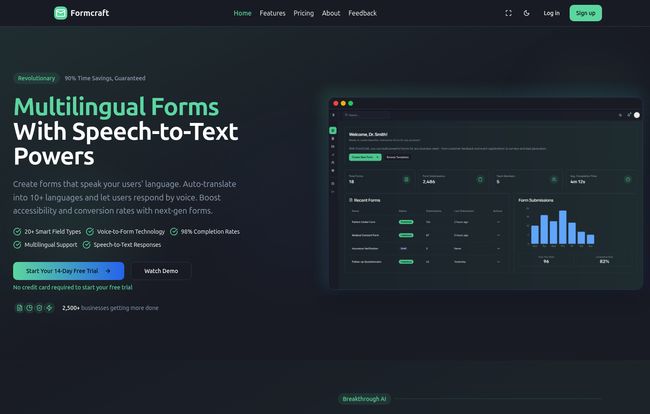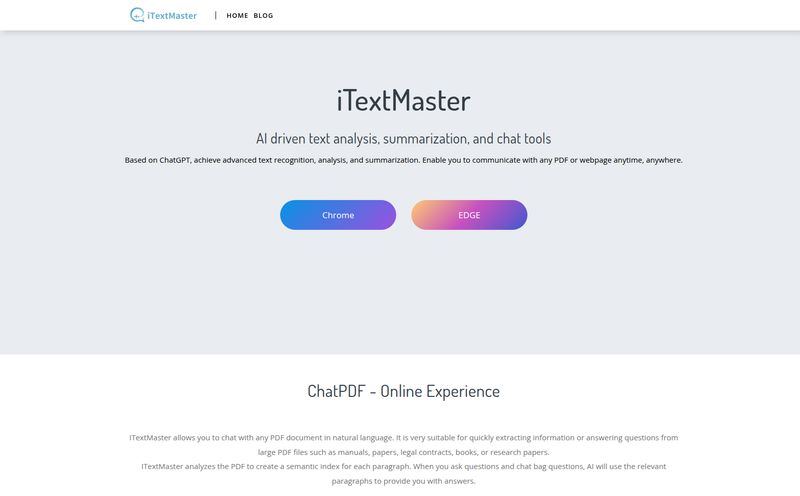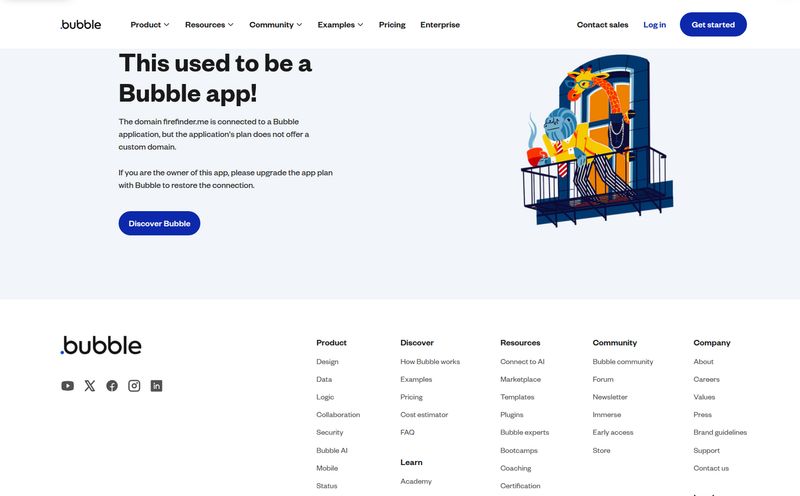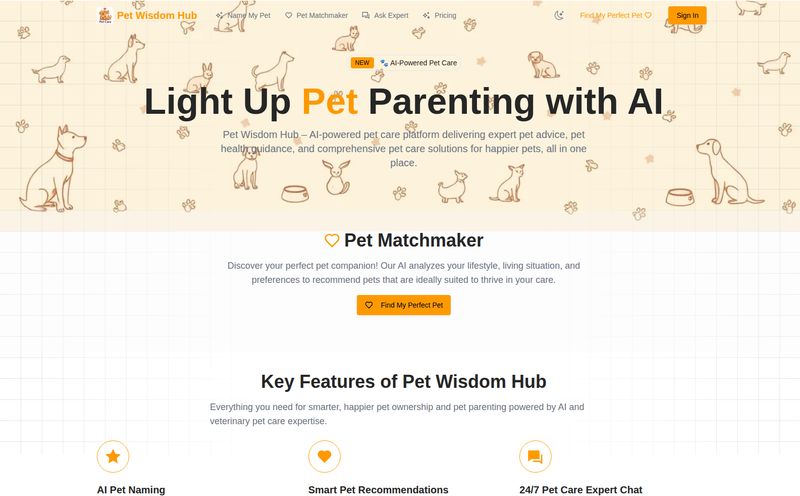If there’s one thing that unites every single person on the internet, it’s the collective sigh we let out when we land on a page with a long, clunky form. You know the one. It asks for your life story, the fields are confusing, and half the time it errors out when you hit submit. As a marketer, I've seen firsthand how a bad form can absolutely murder conversion rates. It's the final hurdle, and we trip over it way too often.
For years, we've tried to make them prettier. We've used multi-step layouts, conditional logic, and all the bells and whistles. But at its core, the process was still the same: manually dragging and dropping fields, hoping we designed something people would actually complete. I’ve spent more hours than I care to admit in the backends of various form builders, tweaking and testing.
Then something like Formcraft comes along. It's not just another builder with a slicker UI. It’s built on a completely different premise, one that involves AI and, get this, your own voice. The claim? You can literally just describe the form you want, and it builds it for you. Wild, right? I was skeptical, but also incredibly intrigued. So, I dug in.

Visit Formcraft
So, What is Formcraft, Exactly?
Okay, stripping away the marketing buzz, Formcraft is an AI-powered platform for creating web forms. But calling it just a “form builder” feels a bit like calling a smartphone just a “phone.” The core difference is the how. Instead of the classic drag-and-drop marathon, its main selling point is the AI Form Generator. You can type a prompt like, “Create a contact form with fields for name, email, phone number, and a message box,” or even say it out loud, and the AI pieces it all together. It's like having a junior developer on standby, ready to spin up forms on command.
This taps directly into the conversational AI trend we're seeing everywhere. We’re getting used to talking to our devices, and Formcraft is betting that we’d rather talk to our software, too. It’s a tool designed to close the gap between an idea and a finished, functional lead-capture machine. And it’s not just about how you build the form; it’s about how your users interact with it.
The Features That Genuinely Caught My Eye
A shiny new tool is only as good as its features. I've seen plenty of platforms with one cool gimmick that falls apart under real-world use. Here’s what I think actually matters in Formcraft.
The AI Voice-to-Form is the Main Event
Let's not bury the lede. The voice-to-form and AI generation is the star of the show. The process feels a little like magic the first time you try it. I found it surprisingly accurate for standard requests. For more complex, multi-page forms with tricky conditional logic, you might still need to do some manual tweaking in their drag-and-drop editor (which, by the way, is clean and easy to use). But for 80% of the forms a typical business needs—contact, registration, feedback, simple quotes—it’s a massive time saver. The old way was like building with LEGOs, carefully picking each brick. This is like telling a master builder, “I need a simple, strong bridge,” and watching them construct it in seconds.
Making Forms Feel Less Like an Interrogation
Here’s where it gets interesting for user experience (UX) and conversion rates. Formcraft allows users to fill out forms using their voice with speech-to-text. Think about how much easier that is on a mobile device. No more fat-fingering your email address for the third time. It’s a small touch that can make a huge difference in reducing friction.
They also have robust multilingual support, with automatic translation. If you have an international audience, this is huge. It shows you respect your user enough to speak their language, which can do wonders for trust and, ultimately, form completion. According to a study by CSA Research, 76% of online shoppers prefer to buy products with information in their native language. While a form isn't a product page, the principle is the same.
The Practical Stuff That Makes It a Business Tool
The AI is cool, but a business needs more. I was happy to see Formcraft includes the essentials. Digital signatures are a must for any kind of agreement or official registration. Folder organization, team collaboration, and enterprise-grade security are all there. These are the boring-but-critical features that mean you can actually run your operations with this tool, not just use it for a landing page gimmick. It’s a serious contender, not a toy.
How This Actually Affects Your Traffic and Conversions
Alright, let’s get down to brass tacks. As an SEO guy, I care about two things: getting traffic and converting it. How does a form builder help?
It’s all about fighting form abandonment. The average form abandonment rate is painfully high—some studies put it close to 70%! A better, faster, more accessible form experience directly tackles this. By making forms conversational and easy to fill out (especially with voice), Formcraft can significantly boost completion rates. More completions mean more leads, more sign-ups, and more sales from the same amount of traffic. Your cost-per-acquisition (CPA) goes down, and your campaign ROI goes up.
Plus, a good user experience can have a halo effect. Google has been clear that user experience is a ranking factor. While they probably aren't crawling your form's usability directly, metrics like time-on-page and bounce rate are affected. A user who has a smooth interaction is more likely to stick around, which sends positive signals to search engines.
Let's Talk Money: The Formcraft Pricing Plans
No review is complete without looking at the price tag. Formcraft uses a pretty standard tiered model. I’ve broken it down here, but you can always check their official pricing page for the latest details.
| Plan | Price (per month) | Who It's For |
|---|---|---|
| Basic | $12 | Perfect for freelancers or small businesses just getting started. You get unlimited forms but are capped at 500 submissions and 1 user. |
| Pro | $24 | The sweet spot for growing businesses. More submissions (2,500/mo), more users (3), and access to all form elements. |
| Business | $49 | This is where the magic happens. You get a huge submission limit (10,000/mo), more users, and critically, access to the AI form generation and priority support. |
My take? If you're serious about leveraging the core AI feature that makes Formcraft special, you really need to be on the Business plan. The lower tiers are solid form builders, but they miss the main headline feature. That said, the Pro plan offers a fantastic middle ground for teams that need more power than Basic but aren't ready for the full AI investment.
The Potential Downsides to Consider
I wouldn’t be doing my job if I didn't point out the potential snags. No tool is perfect. First, there's a slight learning curve to get the most out of the AI. You have to learn how to phrase your requests to get the form you really want. Second, you are placing a lot of trust in the AI's accuracy. I'd always recommend double-checking any form it generates, especially if it's complex. And finally, the pricing. While competitive, the $49/month for the full AI experience might be a bit steep for very small businesses or solopreneurs just starting out.
Frequently Asked Questions About Formcraft
Is there a free trial for Formcraft?
Yes, absolutely. They offer a 14-day free trial, and you don't need a credit card to sign up. This is a great way to test out the features, especially the AI generator on the Business plan, to see if it fits your workflow.
What happens to my forms if my trial ends?
According to their site, your forms and data won’t be lost. You'll just need to upgrade to a paid plan to continue using all the features. It's a pretty standard and fair approach.
Is the AI form generation unlimited?
On the Business plan, they state you can create as many AI forms as you need. There doesn't appear to be a hard limit, which is a big plus.
How does Formcraft compare to Google Forms or Typeform?
Google Forms is free and basic. Formcraft is in a different league entirely. Compared to Typeform, which pioneered the one-question-at-a-time conversational style, Formcraft's differentiator is the AI-driven creation process and voice input features. Typeform is about the user's conversational experience; Formcraft is about that plus the creator's AI-assisted experience.
Is it secure enough for sensitive information?
Formcraft promotes its enterprise-grade security features. With things like digital signatures available, they are clearly targeting professional use cases. As with any third-party tool, you should review their security and privacy policies, but it seems built for business needs.
My Final Verdict on Formcraft
So, is Formcraft a game-changer? For a certain type of user, I think it is. If you or your team spend a significant amount of time building and managing forms, the efficiency gains from the AI generator could be massive. The investment in the Business plan could pay for itself in saved hours very quickly.
It represents a genuine shift in how we interact with software—moving from manual command to creative collaboration with AI. It’s not just a better mousetrap; it’s a whole new way to catch mice. While it might be overkill for someone who needs one simple contact form, for agencies, marketing teams, and growing businesses, Formcraft is a seriously compelling tool that's worth putting through its paces. The future of data collection is looking a lot more conversational, and a lot less tedious.
Reference and Sources
- CSA Research: Can't Read, Won't Buy – B2C
- Formcraft Official Website
- Formcraft Official Pricing Page



